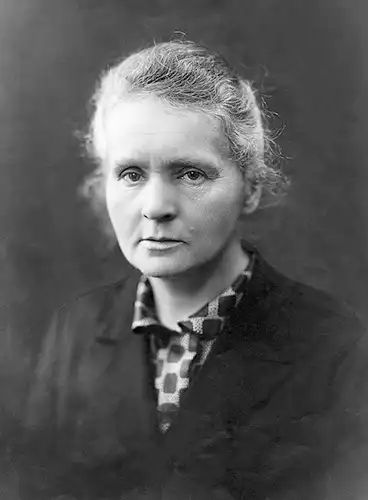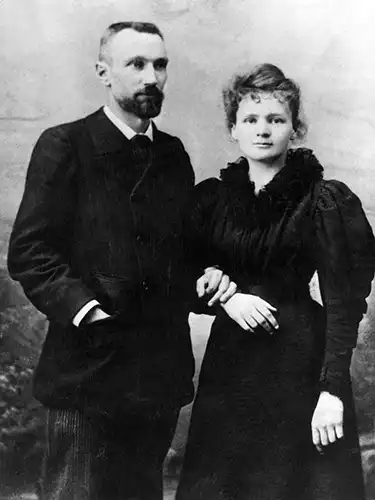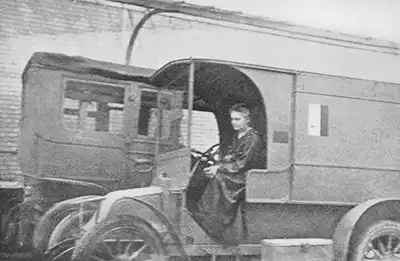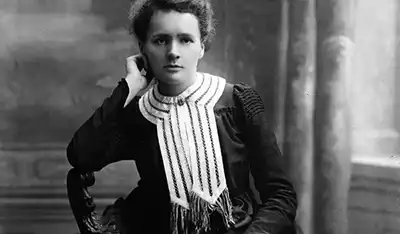Marie Curie, a scientist of Polish origin, revolutionized the study of radioactivity and, with her husband Pierre, discovered the chemical elements radium and polonium.
Her works helped to change the history and direction of the study of radioactivity. She also showed the world the intellectual value and rich contribution that women could provide to the scientific world, which was, in the past, predominantly male in nature.
Marie Curie was the first woman to receive a Nobel prize, and the first person to receive it twice. She was awarded the Nobel prize in 1903, for Physics, and then in 1911, for Chemistry. Marie Curie and Linus Pauling are the only Nobel prize winners who received Nobel prizes in different fields.

Marie Curie was born Maria Salomea Skłodowska in 7/November/1867 in Poland. When she was 10 years old, she began attending a boarding school and, then, she attended a gymnasium for girls, where she graduated at the age of 15 with a gold medal.
Unable to enroll in a regular institution of higher education because she was a woman, she and her sister Bronislawa became involved with the clandestine Flying University (also known as Floating University) that was a Polish institution of higher education that admitted women.
When Bronislawa got married to a polish physician, she moved to Paris her new husband. She invited Marie to join them but Marie declined because she couldn’t afford tuition at the university in Paris.
While working as a governess, Marie continued to educate herself by reading books, exchanging letters, and being tutored herself. Her first practical scientific training started in 1890 in a chemistry laboratory at the Museum of Industry and Agriculture in Warsaw. In 1891 she decided to leave Poland, moving to Paris. After arriving she was able to enroll at the University of Paris, where she proceeded with her studies of physics, chemistry and mathematics.
In 1893 she got a degree in physics and started working at an industrial laboratory. Meanwhile, she continued studying at the University of Paris and was able to get a second degree in 1894.
Pierre and Marie Curie

Her scientific career began in Paris, investigating magnetic properties of various steels. It was when she met Pierre Curie, who was an instructor at The City of Paris Industrial Physics and Chemistry Higher Education Institution.
Their mutual passion for science brought them closer until they began to have feelings for one another. Eventually, Pierre proposed marriage but Maria declined. She wanted to move back to Poland to work in her chosen field. She moved back to Poland but was denied a place at Krakow University because she was a woman.
After that, Pierre was able to convince her to go back to Paris to pursue a PhD. She went back to Paris and they got married in 1895 and in 1897 their first daughter, Irene, was born.
To support their family, Pierre started teaching at the École Normale Supérieure in Paris.
Even though they didn’t have a proper laboratory to work, they continued their research on a converted shed next to the school. Unfortunately, the effects of radiation where not known at the time, so they continued working with radioactive substances unprotected.
In July 1898 they published a joint paper announcing the existence of a new element they named “polonium”. That same year, in December, they announced the existence of another element, that they named “radium”, which was the Latin word for “ray”. During their research of the “radium” they coined the word “radioactvity”.
In 1900, Marie Curie became the first woman faculty member at the École Normale Supérieure. In 1903 she was awarded her doctorate from the University of Paris. That same month, the Curies were invited to the Royal Institution in London to give a speech on radioactivity. Marie Curie wasn’t allowed to speak though, because she was a woman.
Between 1898 and 1902, they published, joint or separately, 32 scientific papers. One of the papers was about tumour-forming cells being destroyed faster than healthy cells, when exposed to “radium”.
Nobel Prize of Physics
The Curies, along with Henri Becquerel, were awarded the Nobel Prize of Physics in 1903 for their work in radioactivity. Marie Curie became the first woman ever to be awarded a Nobel Prize. But the committee’s initial intention was to nominate only Pierre and Henri. At Pierre’s protests, they included Marie in the nomination.
They were very busy with their work so they didn’t want to travel to Stockholm to receive the prize in person. But Nobel Laureates were required to deliver a lecture and they traveled in 1905. After the award, Pierre Curie received an offer for a position at the University of Geneva. Then, the University of Paris offered him a professorship and the chair of physics.
In 1904 their second daughter, Ève, was born. Marie hired polish governesses to teach their daughters Polish.
In 1906 Pierre Courie was killed after being struck by a horse drawn vehicle. Curie was devastated by his death. One month later, the physics department of the University of Paris offered Marie the chair that had been created for her late husband. She accepted becoming the first woman teacher at the University and hoping to create a world-class laboratory in honor of her late husband.
Radium Institute (now Curie Institute)
It was not until 1909 that she was able to have a proper laboratory to work. The University of Paris never attended her demands. In 1909, the director of the Pasteur Institute, Pierre Paul Émile Roux, disappointed with the University of Paris for not giving Curie a proper laboratory, suggested her to come to the Pasteur Institute. With the threat of her leaving, the University of Paris, in a joint effort with the Pasteur Institute, created the Pavilion Curie of the Radium Institute, where a proper laboratory was installed.
The Radium Institute was finally founded in 1914. The institute has played a crucial role in continuing research in nuclear physics, cancer treatment, and other related fields.
Nobel Prize of Chemistry
In 1910, she succeeded in isolating radium, defining an international standard for radioactive emissions.
International recognition for Marie Curie’s work had been growing. In 1911, the Royal Swedish Academy of Sciences honored her a second time with a Nobel Prize of Chemistry. The award was “in recognition of her services to the advancement of chemistry by the discovery of the elements radium and polonium, by the isolation of radium and the study of the nature and compounds of this remarkable element”1.
Marie Curie in World War I
Marie Curie inside a “petite Curie”, a mobile x-ray vehicle

During the war Marie Curie saw the need for radiology centers near the front lines to assist surgeons on treating wounded soldiers. She was able to develop a mobile radiography unit, which became known as “petites Curies” (little Curies).
She became the director of the Red Cross Radiology Service and, along with a military doctor and her daughter Irene, was able direct the installation of 20 mobile radiology vehicles and 200 radiology units at field hospitals.
She also tried to help the war effort by donating her Nobel Prize medals but the French National Bank refused. But she managed to use the prize money to buy war bonds.
Postwar years
In 1920 the French government established and stipend for Marie Curie. The previous recipient of this stipend was Louis Pasteur, who had died 25 years before.
In 1921 and 1922 she visited various countries appearing publicly and giving lectures. She was also received by the United States president at the White House, who gave her 1 gram of radium that was collected in the United States.
Led by Curie, the Radium Institute produced four more Nobel Prize winners including her daughter, Irene Joliot-Curie, and Irene’s husband, Frédéric Joliot-Curie.
The last years
During Marie Curie’s lifetime, the damaging effects of ionising radiation were not known. No safety measures existed at the time. She used to carry test tubes with radioactive isotopes inside her pocket and stored them in her desk drawer. She was also exposed to radiation by the radiology equipment she used during World War I.
Her papers from the 1890s are considered too dangerous to handle due to the level of radioactive contamination. They are kept in lead-lined boxes and to consult them, one must wear protective clothing.
She died at age 66 in 1934 from aplastic anemia believed to have been contracted from her long exposure to radiation, causing damage to her bone marrow. She was interred in Sceaux, alongside with her husband.
During the last year of her life, she worked on a book called Radioactivity, which was published after she died.
In 1995, the remains of Pierre and Marie Curie were transferred to the Paris Pantheón. Their remains were sealed in a lead lining because of the radiation. She became the second woman to be interred at the Paris Pantheón, but the first woman to achieve it on her own merits.
Legacy of Marie Curie
During her life she received numerous honors and awards during her lifetime, including honorary degrees, memberships in scientific societies, and various medals. Her legacy is celebrated through numerous institutions, scholarships, and awards named in her honor.
Marie Curie’s legacy extends far beyond her scientific contributions; she is remembered as a trailblazer for women in science and a symbol of dedication and perseverance in the pursuit of knowledge.
Bibliography
- Marie Curie – Scandal and Recovery (1910–1913) Part 2″. American Institute of Physics. Archived from the original on 12 September 2011. Retrieved 7 November 2011.
- Marie Curie – Wikipedia
- Marie Curie – Brasil Escola UOL

